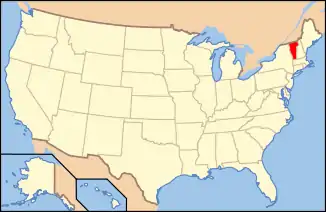Vermont wine
Vermont wine refers to wine made from grapes grown in the U.S. state of Vermont. The first commercial winery in Vermont, Snow Farm Winery, opened in 1997. Vermont is a very cold climate for viticulture. Vermont wineries have focused on using cold-hardy French hybrid grapes, but have been experimenting with some Vitis vinifera varieties. Some Vermont wineries produce wine made from grapes grown in other states, especially New York.[1][2]
| Wine region | |
 | |
| Official name | State of Vermont |
|---|---|
| Type | U.S. State Appellation[1] |
| Years of wine industry | 53[2] |
| Country | United States |
| Total area | 9,620 square miles (6,156,800 acres) |
| Size of planted vineyards | 175 acres (71 ha)[3] |
| No. of vineyards | 3[1] |
| Grapes produced | Baco noir, Cayuga, Chardonnay, Frontenac, Leon Millot, Marechal Foch, Riesling, Seyval blanc, St. Croix, Traminette, Vidal blanc, Vignoles, Zweigelt[3][1] |
| No. of wineries | 7[1] |
Vermont is a center for natural wine and biodynamic wine production.[4]
References
- "Vermont: Appellation Profile". Appellation America. 2007. Archived from the original on September 4, 2013. Retrieved November 28, 2007.
- Trzaskos, Todd (September 14, 2015). Wines of Vermont: A History of Pioneer Fermentation. The History Press. p. 176. ISBN 978-1-46-711813-2.
- Cannella, Mark. "2015 Vermont Vineyard Feasibility Study" (PDF). University of Vermont.
- Jacobsen, Rowan (December 17, 2019). "New England's Winemakers Don't Care How They Do It in California". Boston Magazine.
This article is issued from Wikipedia. The text is licensed under Creative Commons - Attribution - Sharealike. Additional terms may apply for the media files.
